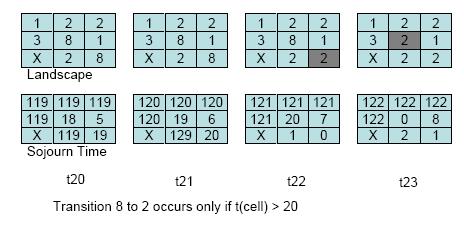Using sojourn time and deterministic transitions
Load the model “simulate_def_aband_and_deterministic_transition.xml” from \Examples\ sim_defor_and_aband_using_sojourn_time_and_deterministic_transition In this example, transition from abandon (land abandoned undergoes regeneration) to forest is deterministically determined based only on the sojourn time. So after a period in regrowth, the abandoned parcel has acquired a forest structure similar to a mature forest, thereby considered as forest. The minimum sojourn time for this transition to occur is 21 years
An additional transition from deforested land to abandon is added to the previous model. Calculate Categorical Map placed at the end of the model is employed to perform this transition. Its rule is the following:
if i1 = 8 and i2 > 20 then 2 else i1
i1 is the landscape map and i2 is the sojourn map (forest is 2, abandon is 8). Note that for simplicity, it’s not possible to clear areas in abandon (transition 8 to 1). This could be added to the model as a new transition. Texeira et al. (2009) provide an example of modeling the landscape dynamics of the Atlantic forest, which includes multistate and transition from forest to various land-use.

